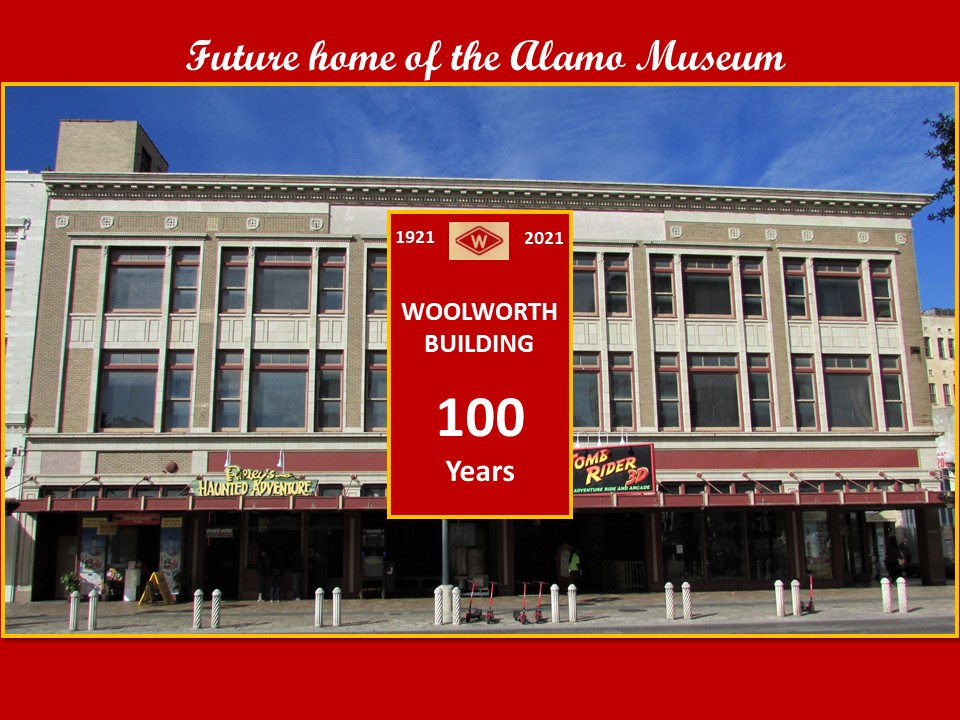
Woolworth’s, a popular national discounter, first came to San Antonio in 1912 and opened a store on E. Houston Street. The company soon prospered enough to erect a new three-story building “on San Antonio’s most prominent corner.” On June 3, 1921, the F. W. Woolworth Company opened its 5, 10, and 15 cent store at the intersection of E. Houston and Alamo Streets on Alamo Plaza, where the Maverick Bank Building once stood.
The newspaper ad announcing Woolworth’s formal opening boasted that, “We have added a number of features to our service – but the one which you will appreciate most is our soda fountain and lunch counter.” This lunch counter, touted by the local manager as the largest in the city, later catapulted San Antonio into civil rights history.
On February 1, 1960, four Black students challenged racial segregation at public eating places by sitting down at a Woolworth lunch counter in Greensboro, North Carolina. They inspired a student-led movement to integrate lunch counters across the South. In some cities, young African Americans faced arrests and violence.
The Woolworth on Alamo Plaza was one of seven local stores that peacefully and voluntarily desegregated their lunch counters on March 16, 1960. No sit-in demonstrations were held and no retaliation followed, thanks to the cooperation of church leaders, store managers, and members of the NAACP, who orchestrated the policy change behind the scenes. Private Richard Hunt, now one of the greatest sculptors in American history, helped integrate the Woolworth lunch counter that day.
This unique, early victory for the sit-in movement made national news and drew praise from baseball great Jackie Robinson, who called it “a story that should be told around the world.” JET Magazine later photographed local Civil Rights leader Mary Lillian Andrews at the Woolworth lunch counter she helped integrate.
The Woolworth Building became part of the Alamo Plaza National Register Historic District in 1977. Inclusion in the city’s local landmark district followed. Even though downtown no longer attracted throngs of shoppers, the lunch counter continued to operate until 1986. The store was considered one of the oldest surviving in the Woolworth chain before it closed in 1997. By this time, it had outlasted local competitors, even Kress.
A short-lived Woolworth-owned Footlocker shoe store opened in the space in 1998. The building almost became a military aviation museum in 1999, but instead housed various entertainment-oriented businesses and fast food restaurants.
In 2015, the State of Texas bought the Woolworth and two other historic buildings. Located directly across from the Alamo, this site was ideally situated for a new Alamo Museum. Between 2016 and mid-2021, the fate of these buildings hung in the balance while the state considered whether to demolish or reuse them.
The Conservation Society, joined by the Coalition for the Woolworth Building, lobbied hard for preserving this Civil Rights landmark. Bexar County Judge Nelson Wolff staunchly backed saving the building, which received State Antiquities Landmark designation from the Texas Historical Commission in 2019. Support continued growing among many leading preservation and cultural heritage organizations.
In 2020, World Monuments Fund (WMF) included the building on the World Monuments Watch, a biennial program spotlighting 25 endangered heritage sites. John G. Waite and Associates, Architects, a leading preservation consultant, later affirmed the historical significance and structural soundness of the Woolworth Building in a report for the Alamo Trust. This report also revealed that Woolworth’s is the only former store that retains any physical evidence of its lunch counter.
Just two weeks before the building’s 100th anniversary, the Alamo Trust shared conceptual plans at Bexar County Commissioners Court that included repurposing the Woolworth Building as part of the new Alamo Museum. The County then pledged $25M over five years to the museum, which will also include a free exhibit interpreting the Woolworth lunch counter and San Antonio’s Civil Rights history. Lt. Governor Dan Patrick has promised an additional $50M from the State of Texas.
With new project leadership and active stakeholder participation, the 100-year-old Woolworth Building faces the future ripe with the potential to connect generations of museum visitors to Texas history in all its richness, complexity and diversity.